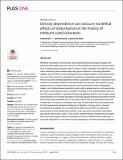Files in this item
Density dependence can obscure nonlethal effects of disturbance on life history of medium-sized cetaceans
Item metadata
| dc.contributor.author | Hin, Vincent | |
| dc.contributor.author | Harwood, John | |
| dc.contributor.author | de Roos, André M. | |
| dc.date.accessioned | 2021-06-07T16:30:08Z | |
| dc.date.available | 2021-06-07T16:30:08Z | |
| dc.date.issued | 2021-06-03 | |
| dc.identifier | 274530081 | |
| dc.identifier | db7a519d-c59c-4f4c-b242-9a0a7dff91a5 | |
| dc.identifier | 000664639200044 | |
| dc.identifier | 85107343236 | |
| dc.identifier.citation | Hin , V , Harwood , J & de Roos , A M 2021 , ' Density dependence can obscure nonlethal effects of disturbance on life history of medium-sized cetaceans ' , PLoS ONE , vol. 16 , no. 6 , e0252677 . https://doi.org/10.1371/journal.pone.0252677 | en |
| dc.identifier.issn | 1932-6203 | |
| dc.identifier.other | Jisc: 9b654cb0a1a44e9f8e467ae112beda44 | |
| dc.identifier.other | publisher-id: pone-d-20-39916 | |
| dc.identifier.uri | https://hdl.handle.net/10023/23328 | |
| dc.description | Funding: This research was supported by the Office of Naval Research (https://www.onr.navy.mil/) grant N00014-16-1-2858: "PCoD+: Developing widely-applicable models of the population consequences of disturbance” awarded to SMRU Consulting Ltd (http://www.smruconsulting.com/). VH and AMdR benefitted from funding from the European Research Council (https://erc.europa.eu/) under the European Union’s Seventh Framework Programme (FP/2007-2013) / ERC Grant Agreement No. 322814 awarded to AMdR. | en |
| dc.description.abstract | Nonlethal disturbance of animals can cause behavioral and physiological changes that affect individual health status and vital rates, with potential consequences at the population level. Predicting these population effects remains a major challenge in ecology and conservation. Monitoring fitness-related traits may improve detection of upcoming population changes, but the extent to which individual traits are reliable indicators of disturbance exposure is not well understood, especially for populations regulated by density dependence. Here we study how density dependence affects a population’s response to disturbance and modifies the disturbance effects on individual health and vital rates. We extend an energy budget model for a medium-sized cetacean (the long-finned pilot whale Globicephala melas) to an individual-based population model in which whales feed on a self-replenishing prey base and disturbance leads to cessation of feeding. In this coupled predator-prey system, the whale population is regulated through prey depletion and the onset of yearly repeating disturbances on the whale population at carrying capacity decreased population density and increased prey availability due to reduced top-down control. In populations faced with multiple days of continuous disturbance each year, female whales that were lactating their first calf experienced increased mortality due to depletion of energy stores. However, increased prey availability led to compensatory effects and resulted in a subsequent improvement of mean female body condition, mean age at first reproduction and higher age-specific reproductive output. These results indicate that prey-mediated density dependence can mask negative effects of disturbance on fitness-related traits and vital rates, a result with implications for the monitoring and management of marine mammal populations. | |
| dc.format.extent | 24 | |
| dc.format.extent | 2433380 | |
| dc.language.iso | eng | |
| dc.relation.ispartof | PLoS ONE | en |
| dc.subject | GC Oceanography | en |
| dc.subject | QH301 Biology | en |
| dc.subject | QL Zoology | en |
| dc.subject | T-NDAS | en |
| dc.subject | SDG 14 - Life Below Water | en |
| dc.subject.lcc | GC | en |
| dc.subject.lcc | QH301 | en |
| dc.subject.lcc | QL | en |
| dc.title | Density dependence can obscure nonlethal effects of disturbance on life history of medium-sized cetaceans | en |
| dc.type | Journal article | en |
| dc.contributor.institution | University of St Andrews. School of Biology | en |
| dc.contributor.institution | University of St Andrews. Centre for Research into Ecological & Environmental Modelling | en |
| dc.identifier.doi | https://doi.org/10.1371/journal.pone.0252677 | |
| dc.description.status | Peer reviewed | en |
This item appears in the following Collection(s)
Items in the St Andrews Research Repository are protected by copyright, with all rights reserved, unless otherwise indicated.

